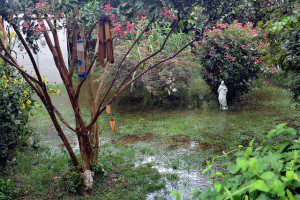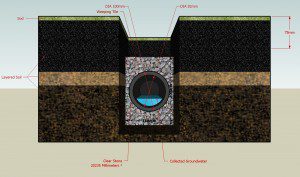Preventing Flooding in your Backyard
After a heavy rain, you may be relieved to discover that none of the water has entered your home. However, if you experience backyard floodingFlooding is the overflow or accumulation of water in areas t... More every time it rains, this could eventually have a damaging affect. FloodingFlooding is the overflow or accumulation of water in areas t... More near the home can seep into your basement and also cause significant damage to the foundation. You must take a concerted effort to prevent floodingFlooding is the overflow or accumulation of water in areas t... More in your backyard if your yard is prone to floodingFlooding is the overflow or accumulation of water in areas t... More after heavy or even moderate rain. Extensive backyard floodingFlooding is the overflow or accumulation of water in areas t... More may require professional help, but these tips can help you prevent water from gathering in your yard.
Yard Drainage to Prevent Flooding
Backyard floodingFlooding is the overflow or accumulation of water in areas t... More is a sure sign of improper drainage. Areas that collect the most water from the rain tend to be low areas at the bottom of a slope. You must take note of which areas of your backyard flood the most heavily to provide proper drainage. The following are the most common yard drainage solutions:
-
- French Drains: French drain systems solve drainage issues by collecting excess water in a perforated pipe and dispersing it evenly in the soil. To install a French drain, you must dig a trench in the most heavily flooded areas of the yard and make sure the trench goes deeper than your home. Place the perforated pipe in the trench and surround it with aggregate material such as gravel to filter the water. The aggregate prevents dirt and debris from reaching the pipe and clogging the perforations. As the pipe collects and redirects the rainwater, it disperses the water back underground through the lower layer of aggregate.

Backyard FloodingFlooding is the overflow or accumulation of water in areas t... More can eventually reach your home.
- Dry Wells: Dry wells are a yard drainage solutionA solution is a homogeneous mixture of two or more substance... More in which underground plastic wells collect the water and slowly release it. You can install a dry well by digging a large hole and placing a perforated dry well in it. These wells are most effective when they are put in the ground at a lower level than the house. You must also surround the wells with aggregate to fill the hole and allow proper drainage. Dry wells temporarily store the water they collect and slowly release it to prevent a quick buildup. You can more directly control where the water drains by attaching additional tunes or pipes to the well.
- Sump Pumps: Many homeowners install sump pumps to prevent floodingFlooding is the overflow or accumulation of water in areas t... More in their homes as well as their yards. Sump pumps are more effective for preventing backyard floodingFlooding is the overflow or accumulation of water in areas t... More than French drains or dry wells but also more expensive. They work by removing the water from the soil and collecting it in their specially dug pits. Once the pit is full, the water is pumped away through a drainage pipe that drains the water at a safe distance.
Other Backyard Flooding Solutions
If you experience floodingFlooding is the overflow or accumulation of water in areas t... More in just a few specific areas of your yard, you can help resolve the issue with these tips:
-
- Elevation: FloodingFlooding is the overflow or accumulation of water in areas t... More generally occurs in low areas of the yard and elevating these areas can effectively prevent floodingFlooding is the overflow or accumulation of water in areas t... More. You can elevate low areas by adding topsoil and mulch which will stop the rainwater from pooling.

Diagram of a French drain.
- Rain Garden: If there is one specific spot in your yard that consistently floods, planting a rain garden is an excellent solutionA solution is a homogeneous mixture of two or more substance... More. Rain gardens include plants with deep roots that thrive in wet conditions and they are planted in areas that collect extra rainwater. You can also install drains around the garden to make sure it doesn’t get too much water. Rain gardens will not only add an appealing feature to your yard, but also reduce runoffRunoff is water from rain or other sources that flows over s... More.
Water damage is already a difficult problem to prevent in your home and backyard floodingFlooding is the overflow or accumulation of water in areas t... More makes it even more likely. These yard drainage solutions are effective for preventing floodingFlooding is the overflow or accumulation of water in areas t... More in your backyard that can leadLead is a heavy metal that can be toxic to humans, especiall... More to damage in your home. If you have experienced heavy floodingFlooding is the overflow or accumulation of water in areas t... More in your yard or your home, you must call water damage restoration experts immediately. These professionals can effectively remove excess water and provide thorough dryingDrying is the process of removing moisture from materials, s... More to prevent damage.












